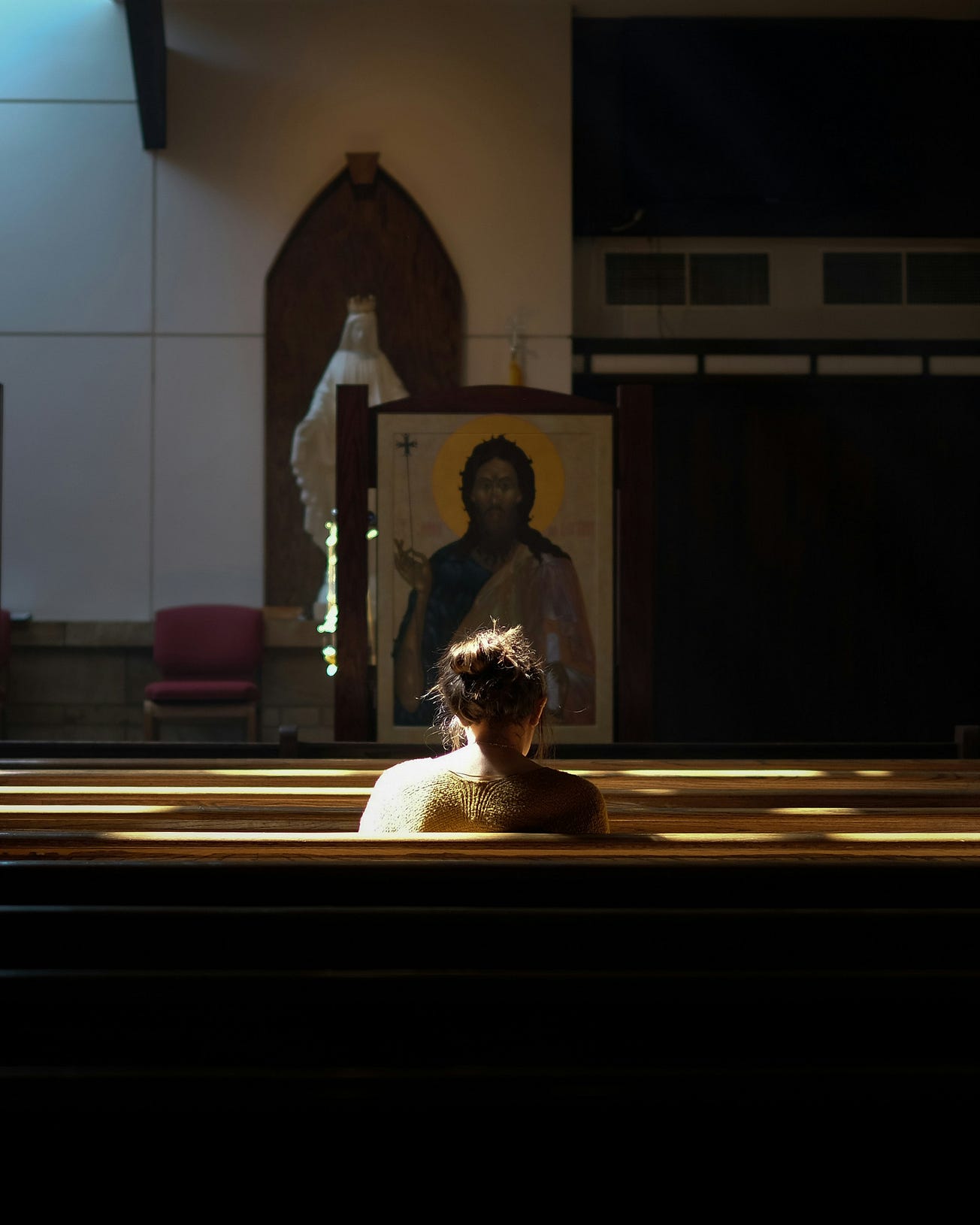Pillar subscribers can listen to this Pillar Post here: The Pillar TL;DR - The Friday Pillar Post
Happy Friday friends,
This weekend is Laetare Sunday, as most of you will realize. It’s one of the two days a year when parish priests become acutely alive to the subtle, imaginary distinction between “rose” and “pink” in the color of their vestments — though I’ve long been of the opinion that real men can and should wear pink when the mood takes them.
Laetare Sunday, like its Advent equivalent Gaudete Sunday, is a moment when the Church calls us to let a little anticipatory joy into our penitential season. I think it’s a very good thing indeed.
In addition to various spiritual disciplines, I’ve myself been using the season (as many do) to lay aside many of the daily indulgences I’m wont to grant myself.
As a by-product, I’ve caught myself cultivating a little misplaced pride at the untouched case of Girl Scout cookies in the basement and celebrating some marginal weight loss as (false) evidence of virtue.
Eating salad and going to bed a little hungry can be good discipline, so long as it’s properly ordered towards a spirit of fasting ahead of a feast. But when it tips over into a kind of bloody-minded self-satisfaction, it becomes unmoored from its true purpose and slips into a Pelagian self-justification. At least it does for me, anyway.
Laetare Sunday, then, comes to remind me that self-deprivation isn’t a morally righteous act at all, and the loss of a few pounds will weigh not an ounce in the balance of my salvation. What matters is my disposition to love God and my neighbor, and to point my life squarely towards the Resurrection of Christ at Easter.
Letting a little joy in the weekend will, I am sure, leaven my Lent and remind me that ours isn’t a faith of miserable self-denial and righteous self-justification. Everything is grace, and grace should be rejoiced over, in every season.
Here’s the news.
The News
The Australian bishops’ conference is facing questions about its previous statements on the Vos estis investigation into Bishop Christopher Saunders.
The police investigation into the bishop was kicked off last year after they were given a copy of the Church’s own Vos estis investigation into the bishop, the results of which have been with the DDF in Rome for some months now.
The problem for the conference is that while Saunders is now charged with multiple sexual offenses against persons under 18, including rape, this somewhat flies in the face of previous Church statements on the nature of his alleged crimes.
According to a statement on the Vos estis investigation into Saunders from the bishops’ conference in September last year, “no potential victims in the report were confirmed or identified as being under the age of 18.”
It’s not clear why the conference was insisting that the accusations against the bishop did not involve any minors, yet six months later the bishop is being charged with more than a dozen such crimes.
Saunders alleged predations against young men have been well known in his diocese and further afield for some years now — he stepped back from ministry for an initial police investigation in 2020, which closed for lack of evidence.
The Church’s own investigation into the bishop ran to some 200 pages and identified seriously problematic behaviors and allegations consistent with grooming young men over decades, but apparently — at least according to the September statement — nothing to do with anyone under 18.
That statement now appears… somewhat at variance with the police’s conclusions after the conference gave them a copy of the same report.
Given the conference said what it said while making clear the bishops were fully cooperating with the cops, there’d obviously be zero mileage in making a deliberately false statement last year. So I’m not leaping to any conclusions on that score.
But the reality gap between the conference’s previous assurance and the charges facing Saunders now does demand some pretty urgent clarification.
Assuming the best here, that new information and witness testimony came to light when the police looked into the results of the Church’s own investigation, it’s worth asking how the cops were able to get from zero alleged minor victims to two counts of rape and 14 counts of unlawful and indecent assault so quickly.
If nothing else, it suggests the Vos estis process was somewhat deficient, as would be the results currently being considered in Rome.
—
New Zealand’s Cardinal John Dew will face no charges after police ended a 10-month investigation into an abuse allegation that the retired Archbishop of Wellington firmly denies.
The claim dates back to 1977, when Dew was an assistant priest in Upper Hutt, a city in Greater Wellington.
“From the moment I was told of this alleged behavior I have strenuously denied that the events described ever happened,” the cardinal said.
“This has now been thoroughly investigated by the New Zealand Police, others have been interviewed, and sworn affidavits provided to the Police prove that these allegations could never have happened.”
Dew, who was Archbishop of Wellington from 2005 to 2023, had stepped back from ministry during the investigation and retired at the age of 75 in May last year.
—
The Spanish bishops’ conference elected as their new president Archbishop Luis Argüello of Valladolid this week.
In recent years, the Spanish bishops have been split over how to confront the crisis of clerical sexual abuse, as well as often at odds with the country’s hard-line secularist government, which has set about shoving the Church to the margins of Spanish society.
While the conference might skew right-leaning, as one source close to the conference told Edgar, “There is no Spanish Strickland.”
This is a very interesting story, read it all.
—
The Church in Slovakia said Tuesday that it had received 68 abuse complaints since 1990, as it released its first comprehensive safeguarding report.
As Vos estis lux mundi turns five years old, these kinds of reports — where they are compiled at all — are an increasingly important gauge of progress in the Church, not just in charting a decline in cases of abuse but in assessing the frankness with which the Church is able to acknowledge past problems.
—
Having endured a years-long liturgical war, the Syro-Malabar Church is now going through something of a confessional conflict over the Filioque clause, the Latin phrase meaning “and from the Son” recited in the Creed during the Eucharist on Sundays.
Historically, this has been an incredibly volatile issue throughout the Catholic Church, though it’s not a debate we tend to think a lot about anymore. In fact, as Luke Coppen explained this week, Eastern Catholic Churches actually tend to get something of a “pass” on affirming the double procession of the Holy Spirit.
But what is the debate all about, and why are Syro-Malabar Catholics debating it now?
Read the whole thing to find out.
Thanks to the generosity of the Knights of Columbus, St. Bernard’s School of Theology and Ministry invites anyone anywhere to audit one summer course entirely free. Learn more about topics such as Catholic author, J.R.R. Tolkien; the relationship between contemplation and cultivation; Pope St. John Paul II’s "Gospel of Life;" and more!
Spy Games
This week, we reported that Italian prosecutors are investigating the illegal accessing of law enforcement databases and systems to search for information on a slate of individuals.
Among the chief suspects for the alleged abuse of the SERPICO and SIVA systems is a detective with the Italian financial police. Go figure. Though on whose behalf he would have been allegedly illegally trawling for information on these people is unknown.
What’s striking to me about this story isn’t so much speculation on who could have procured such a service from within the world of Vatican intrigue, but that it could have been basically anyone.
The most remarkable side story to come out of the Vatican financial trial has been the casual and apparently pervasive use by Vatican officials of private contractors and security personnel to conduct off-books and sometimes obviously illegal surveillance.
The current sostituto, Archbishop Edgar Peña Parra, for example, didn’t just admit to ordering extra-legal retaliatory spying on Vatican banking officials, he downright boasted of it in court and said he’d do it again if the mood took him.
Other uncharged, and largely under-investigated and reported, side shows of the saga include Marogna claiming to have compiled dossiers of compromising information on senior Vatican officials for Cardinal Becciu, and a raft of businessmen leaning on their self-described “fairly good relations with the world of Italian intelligence” in the course of doing business with the Holy See.
Yet almost none of this makes the news. I just don’t get it.
Don’t get me wrong, tracking the ins and outs of the wider financial scandal is a mammoth task and you need to be in a very lucky position as a reporter to have the time and resources to sink into chasing it all down. And that’s before you deal with the question of arguing with editors for column inches to print what you find.
While we’ve made it a core mission here at The Pillar to do so, as a matter of historical record and public accountability, I don’t begrudge any journalist or outlet for throwing their hands up and saying, “We simply can’t follow all this, and no one wants to read it all anyway.”
But when it comes to all these spy games going on, it just baffles me no one seems to make much of it.
I don’t know a single person working in the Roman curia who doesn’t routinely joke about all the phones being bugged, or make rueful cracks about who the office spy is known to be in every department.
When it comes to spying, Vatican City is one of the most casually lawless espionage states in the world, and if anyone could doubt it, the most senior officials in the place spent two years going on the record, under oath, talking about it in open court.
I’d call all this absolute manna of the kind of infotainment that broadsheet newspapers usually ask of their foreign correspondents, and fodder for a brilliant Netflix series. Yet hardly any of it seems to register.
We’ll see how the Italian case progresses. There’s a lot we don’t know yet, but if I had to guess I would put my money on a loose group of guys, possibly cops and similar with access to SERPICO and other such databases, running a kind of private search service on the QT for shady customers.
If that’s what was going on, they’ll be looking to cut a deal and that means ratting out their most high-profile customers. And if I were, speaking hypothetically, a bent Italian financial police detective, it wouldn’t be my dangerous mob clients I’d be selling out first.
No, it would be the name-brand Vatican prelates who could make a prosecutor’s career at no risk to my life who I’d be dropping a dime on first. That’s just my prediction, hypothetically speaking.
The call of the wild, and the moose penalty
I do not know how many of you have been following this year’s Iditarod, the 1,000-mile Alaskan dog sled race between Anchorage and Nome, but it’s a fascination of mine.
The event has been going since 1973 and bills itself as “the last great race.” Competitors - “mushers” - drive teams of up to 16 dogs, at least five of which have to finish the race, which takes more than a week and passes through the last literal blank spot on the American map.
The sheer logistics of the thing are incredible in themselves. The dogs burn around 10-12,000 calories a day, each, which is the functional equivalent of 21 Big Macs, and provisions for the teams have to be flown into the various checkpoints ahead of the race — air and sled are about the only way to get to most of the course.
You have to want to compete in the Iditarod — it’s not like the London Marathon, where the back end of the field is clogged with oddballs in weird costumes doing it for charity and a lark.
Teams can spend up to $100k on being in the race, and you have to prove your fitness to compete over a series of smaller races even to be let in. The average purse for finishing first nets you a lot less than you likely spent to run the course.
There are sponsorships, sure, but these have been declining in recent decades too, along with the prize money.
The people who do this are doing it for their own reasons, but they aren’t financial. There’s a lot of pride involved, I am sure. But I imagine that, at bottom, the thing that drives most of the entrants is a nagging existential question: Can I?
Can they measure up physically to the wind and weather (recorded at times at -76°C, or -100°F with the windchill), and mentally to the total darkness and the endless sky, rocketing across frozen lakes and rivers and up mountains?
I suppose we all casually wonder about the upper limits of our own courage and drive, and I think there is probably something primal within us that craves the clarity of an endeavor in which success and survival are functionally the same thing.
But I cannot imagine what it must be like living with an inner voice that questions you at such volume as to drive you and a dozen dogs into the wilderness in winter.
There’s a stark, distilled poetry to the thought of the Alaskan wilds, as captured so brilliantly by Jack London, whose own troubled, strange, and terrible biography drove him to oyster piracy, sealing, vagrancy and eventually the Klondike during the gold rush of the 1890s.
London was the first great American writer whose prose I fell in love with.
I reread “The Call of the Wild” the other year, after I discovered reading aloud to the newborn baby settled her, but that even if she didn’t understand the story she was very choosy about meter and scansion. I can’t say if it held me spellbound more as a child or a man, and I think that ambiguity is the true mark of genius.
While I stand by my allegiance to Norman Maclean as the finest American short story author, and my favorite writer, London’s “To Build A Fire” may be the finest, bleakest, most unsentimental but stylistically beautiful portrait of American hubris I can think of.
I imagine many of the Iditarod’s mushers have the same wolves of optimism and reality wrestling for their mortality somewhere within them.
Of course, one can over-romanticize these things. Mushing 1,000 miles through the Alaskan interior is about unique practicalities, not poetry, as witnessed by current race leader and five-time champion Dallas Seavey this week.
Seavey was approaching Finger Lake on the way to the Cripple checkpoint when he had to kill a moose — not the sort of thing that comes up in your average NASCAR race, for example.
Race rules actually specify exactly when you can kill a moose (or other big game animal) during the race, which is only allowed “in defense of life or property.” Having done so, the musher is required to immediately halt and gut the animal, defined as “taking out the intestines and other internal organs of (a fish or other animal) before cooking it.”
Not wasting meat is a big deal in Alaska, and properly gutting the moose is essential to keep it from spoiling. The kill is then to be reported at the next checkpoint so that marshals can harvest the animal and see the meat is used.
Now, you might think that having just fended off a large threat to life and property, being forced to stop and clean it is a pretty punitive requirement that would cost a musher valuable time. In fact, you lose no competitive advantage — other racers are forbidden from passing you while you clean the kill, and are required instead to stop and help.
But, in this case, Seavey incurred a two-hour penalty after the race panel determined the moose was “not sufficiently gutted by the musher,” which he was doing on his own, in the dark, on a steep downhill slope, in the snow.
Those are the rules.
Anyway, Seavey served his penalty when he made a mandatory 24-hour rest stop at the halfway point of the race.
The relative threat posed to life and limb by moose is, by the way, a perennial point of debate here in The Pillar’s offices, don’t ask me why.
M’collegue Michelle La Rosa is forever trying to impress upon me the lethal effectiveness of what is, essentially, a cow drawn by an inebriated child.
Luke, a sensible Englishman from the Home Counties, reasonably dismisses reports of any animal larger than a badger as a mythical figment of American exaggeration.
JD, on the other hand, being a Jersey boy trying to live up to his Colorado zip code, is forever regaling us with tales of how he once killed a charging bull with the power of his voice, while spamming our inboxes with graphic how-to videos on proper moose gutting technique.
Anyway, Mich initially greeted the news of Seavey’s encounter as proof of her thesis that these bovine mastodons stalk the wilderness like primeval monsters in search of prey. Though Seavey’s own account of the incident, that the animal basically fell down a hill and became entangled in his sled harness, rather gives the lie to that.
As does the account of musher Jessie Holmes, who also encountered a moose on the same stretch of the course. “I had to punch a moose in the nose out there,” he told media at the next checkpoint, without developing his account further.
I submitted to Michelle that an animal 10 times your size which you can effectively deter with a punch on the snout isn’t properly “life-threatening.” She responded by calling Holmes a “100% liar,” which I think is a bold claim against the integrity of a guy already out there doing something more badass than either one of us is ever likely to try.
I’m not saying moose-related death or injury is impossible, to be clear. You don’t want to hit one at speed, since they are basically built like a 1984 Oldsmobile Firenza station wagon balanced on four broom handles.
But if it’s a moose that does do for me in the end, I suspect I’ll have died laughing at it — we’re talking about creatures that, when they aren’t tripping over their own feet and falling onto dog sleds, get drunk on rotting apples and then stuck in a tree.
Anyway, Seavey is still in the hunt, albeit with his penalty, and he’s gunning for a record sixth Iditarod title, so the stakes are high.
Good luck to him out there.
See you next week,
Ed. Condon
Editor
The Pillar







